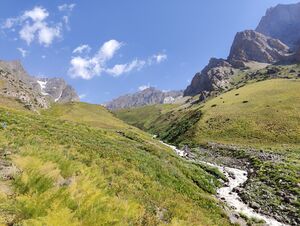Ungauged catchments: различия между версиями
Перейти к навигации
Перейти к поиску
Avdeevdm (обсуждение | вклад) |
Avdeevdm (обсуждение | вклад) (Изменены ссылки на статьи) |
||
| Строка 3: | Строка 3: | ||
==Гидрометрически неизученный водосбор== | ==Гидрометрически неизученный водосбор== | ||
| − | Водосбор, где нет данных о расходах рек. Для данных водосборов параметры моделей "осадки-сток" не могут быть получены калибровкой данных о расходах, и должны быть получены другими методами.<ref name=":0">Bárdossy A. Calibration of hydrological model parameters for ungauged catchments // Hydrology and Earth System Sciences. – 2007. – | + | Водосбор, где нет данных о расходах рек. Для данных водосборов параметры моделей "осадки-сток" не могут быть получены калибровкой данных о расходах, и должны быть получены другими методами.<ref name=":0">Bárdossy A. Calibration of hydrological model parameters for ungauged catchments // Hydrology and Earth System Sciences. – 2007. – Vol. 11. – № 2. – P. 703-710. <nowiki>https://doi.org/10.5194/hess-11-703-2007</nowiki>.</ref> |
==Определение на английском== | ==Определение на английском== | ||
| Строка 11: | Строка 11: | ||
# However, some studies have reported that the relationships between model parameters and catchment descriptors are often complex, and estimation in ungauged catchments usually leads to large errors.<ref name=":1">Blöschl G. Rainfall‐Runoff Modeling of Ungauged Catchments // Encyclopedia of Hydrological Sciences. – 2005. <nowiki>https://doi.org/10.1002/0470848944.hsa140</nowiki>.</ref> | # However, some studies have reported that the relationships between model parameters and catchment descriptors are often complex, and estimation in ungauged catchments usually leads to large errors.<ref name=":1">Blöschl G. Rainfall‐Runoff Modeling of Ungauged Catchments // Encyclopedia of Hydrological Sciences. – 2005. <nowiki>https://doi.org/10.1002/0470848944.hsa140</nowiki>.</ref> | ||
| − | # The (usually unknown) non-linear relationships between the parameters and make their transfer to ungauged catchments extremely difficult.<ref name=":2">Wu H., Zhang J., Bao Z., Wang G., Wang W., Yang Y., Wang J. Runoff Modeling in Ungauged Catchments Using Machine Learning Algorithm-Based Model Parameters Regionalization Methodology // Engineering. – 2023. – | + | # The (usually unknown) non-linear relationships between the parameters and make their transfer to ungauged catchments extremely difficult.<ref name=":2">Wu H., Zhang J., Bao Z., Wang G., Wang W., Yang Y., Wang J. Runoff Modeling in Ungauged Catchments Using Machine Learning Algorithm-Based Model Parameters Regionalization Methodology // Engineering. – 2023. – Vol. 28. – P. 93-104. <nowiki>https://doi.org/10.1016/j.eng.2021.12.014</nowiki>.</ref> |
| − | # The regression relationships were graded from good to poor but the utility of the relationships in predicting stream flow in ungauged catchments was not directly presented.<ref name=":3">Young A.R. Stream flow simulation within UK ungauged catchments using a daily rainfall-runoff model // Journal of Hydrology. – 2006. – | + | # The regression relationships were graded from good to poor but the utility of the relationships in predicting stream flow in ungauged catchments was not directly presented.<ref name=":3">Young A.R. Stream flow simulation within UK ungauged catchments using a daily rainfall-runoff model // Journal of Hydrology. – 2006. – Vol. 320. – № 1-2. – P. 155-172. <nowiki>https://doi.org/10.1016/j.jhydrol.2005.07.017</nowiki>.</ref> |
==Перевод использования на русском языке== | ==Перевод использования на русском языке== | ||
Версия 22:42, 25 апреля 2024
Гидрометрически неизученный водосбор
Водосбор, где нет данных о расходах рек. Для данных водосборов параметры моделей "осадки-сток" не могут быть получены калибровкой данных о расходах, и должны быть получены другими методами.[1]
Определение на английском
Catchments where no runoff data are available are termed ungauged catchments. For these catchments, the parameters of rainfall-runoff models cannot be obtained by the calibration on runoff data and hence need to be obtained by other methods.[1]
Пример использования термина на английском языке
- However, some studies have reported that the relationships between model parameters and catchment descriptors are often complex, and estimation in ungauged catchments usually leads to large errors.[2]
- The (usually unknown) non-linear relationships between the parameters and make their transfer to ungauged catchments extremely difficult.[3]
- The regression relationships were graded from good to poor but the utility of the relationships in predicting stream flow in ungauged catchments was not directly presented.[4]
Перевод использования на русском языке
- В некоторых исследованиях говорится, что отношения между параметрами модели и водосбора часто сложны, и определение параметров неизученных водосборов обычно ведёт к большим ошибкам. [2]
- Нелинейные и обычно неизвестные связи между параметрами модели, часто делают их перенос на гидрометрически неизученные водосборы слишком сложным.[3]
- Регрессионные закономерности получили оценки от хороших до плохих в моделировании, однако практичность этих закономерностей в для предсказания стока в гидрометрически неизученных водосборах не была доказана.[4]
Список литературы
- ↑ 1,0 1,1 Bárdossy A. Calibration of hydrological model parameters for ungauged catchments // Hydrology and Earth System Sciences. – 2007. – Vol. 11. – № 2. – P. 703-710. https://doi.org/10.5194/hess-11-703-2007.
- ↑ 2,0 2,1 Blöschl G. Rainfall‐Runoff Modeling of Ungauged Catchments // Encyclopedia of Hydrological Sciences. – 2005. https://doi.org/10.1002/0470848944.hsa140.
- ↑ 3,0 3,1 Wu H., Zhang J., Bao Z., Wang G., Wang W., Yang Y., Wang J. Runoff Modeling in Ungauged Catchments Using Machine Learning Algorithm-Based Model Parameters Regionalization Methodology // Engineering. – 2023. – Vol. 28. – P. 93-104. https://doi.org/10.1016/j.eng.2021.12.014.
- ↑ 4,0 4,1 Young A.R. Stream flow simulation within UK ungauged catchments using a daily rainfall-runoff model // Journal of Hydrology. – 2006. – Vol. 320. – № 1-2. – P. 155-172. https://doi.org/10.1016/j.jhydrol.2005.07.017.
